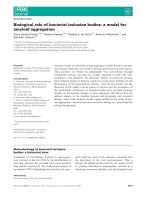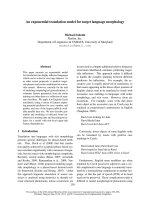An Object-Oriented Programming Model for Event-Based Actors potx
Bạn đang xem bản rút gọn của tài liệu. Xem và tải ngay bản đầy đủ của tài liệu tại đây (531.99 KB, 107 trang )
Universität Karlsruhe (TH)
Fakultät für Informatik
Institut für Programmstrukturen und Datenorganisation
An Object-Oriented Programming
Model for Event-Based Actors
Diploma Thesis
Philipp Haller
May 2006
Referees:
Prof. Martin Odersky, EPF Lausanne
Prof. Gerhard Goos, Universität Karlsruhe
Ich erkläre hiermit, dass ich die vorliegende Arbeit selbständig verfasst
und keine anderen als die angegebenen Quellen und Hilfsmittel verwendet habe.
Lausanne, den 15. Mai 2006
Abstract
Actors are concurrent processes which communicate through asynchronous message passing. Most existing actor languages and libraries
implement actors using virtual machine or operating system threads. The
resulting actor abstractions are rather heavyweight, both in terms of memory consumption and synchronization. Consequently, their systems are
not suited for resource-constrained devices or highly concurrent systems.
Actor systems that do provide lightweight actors, rely on special runtime
system implementations.
Moreover, virtually all languages with a notion similar to actors support
events or blocking operations only through inversion of control which
leads to fragmentation of program logic and implicit control flow that is
hard to track.
We show how lightweight actors can be implemented on standard, unmodified virtual machines, such as the Java Virtual Machine. For this
purpose, we propose an event-based computation model which does not
require inversion of control. The presented actor abstractions are implemented as a library for Scala rather than as language extensions.
The evaluation consists of two parts: In the first part we compare performance to an existing Java-based actor language. In the second part we
report on experience implementing a distributed auction service as a case
study.
v
Acknowledgments
First of all, I would like to thank Prof. Martin Odersky for welcoming
me as a visiting student during the last six months. Without his constant
support this thesis would not have been possible. Thanks to Dr. Lex Spoon
for many helpful discussions and being a congenial office mate. Burak
Emir provided numerous suggestions for improvement by correcting draft
versions of this thesis. Thanks to Sébastien Noir for his help in finding
and fixing bugs in the runtime system, and for porting it to JXTA. Prof.
Jan Vitek provided valuable suggestions for improving the performance
evaluation. Thanks to Dr. Sean McDirmid for making me think about
the relationship between events and actors, and for pointing me to recent
publications. Finally, I would like to thank Prof. Gerhard Goos for being
my referee in Karlsruhe.
vii
Contents
Abstract
v
Acknowledgments
1
vii
1
1.1
Goal . . . . . . . . . . . . . . . . . . . . . . . . . . . . . . . . .
3
1.2
Proposed Solution . . . . . . . . . . . . . . . . . . . . . . . . .
4
1.3
2
Introduction
Contributions . . . . . . . . . . . . . . . . . . . . . . . . . . .
4
Background & Related Work
7
2.1
Actor Model of Computation . . . . . . . . . . . . . . . . . .
7
2.2
Scala . . . . . . . . . . . . . . . . . . . . . . . . . . . . . . . .
8
2.2.1
Higher-Order Functions . . . . . . . . . . . . . . . . .
8
2.2.2
Case Classes and Pattern Matching . . . . . . . . . . .
9
2.2.3
Partial Functions . . . . . . . . . . . . . . . . . . . . .
10
Programming Actors in Scala . . . . . . . . . . . . . . . . . .
11
2.3
ix
x
CONTENTS
2.4
Actor Foundry . . . . . . . . . . . . . . . . . . . . . . . . . . .
15
2.6
SALSA . . . . . . . . . . . . . . . . . . . . . . . . . . . . . . .
15
2.7
Concurrency Control Runtime . . . . . . . . . . . . . . . . . .
16
2.8
Timber . . . . . . . . . . . . . . . . . . . . . . . . . . . . . . .
16
2.9
Frugal Mobile Objects . . . . . . . . . . . . . . . . . . . . . .
17
2.10 Java Extensions: JCilk, Responders . . . . . . . . . . . . . . .
18
2.11 Summary . . . . . . . . . . . . . . . . . . . . . . . . . . . . . .
18
Event-Based Actors
21
3.1
Execution Example . . . . . . . . . . . . . . . . . . . . . . . .
22
3.2
Single-Threaded Actors . . . . . . . . . . . . . . . . . . . . .
25
3.2.1
Receive . . . . . . . . . . . . . . . . . . . . . . . . . . .
26
3.3
Multi-Processors and Multi-Core Processors . . . . . . . . .
27
3.4
Blocking Operations . . . . . . . . . . . . . . . . . . . . . . .
29
3.4.1
Implementation . . . . . . . . . . . . . . . . . . . . . .
32
3.5
Timeouts . . . . . . . . . . . . . . . . . . . . . . . . . . . . . .
33
3.6
4
14
2.5
3
Actors for Smalltalk . . . . . . . . . . . . . . . . . . . . . . . .
Event-Driven Applications . . . . . . . . . . . . . . . . . . . .
34
Runtime System
39
4.1
Architecture . . . . . . . . . . . . . . . . . . . . . . . . . . . .
39
4.1.1
40
Service Layer . . . . . . . . . . . . . . . . . . . . . . .
CONTENTS
4.1.2
xi
Process Identifiers . . . . . . . . . . . . . . . . . . . .
40
4.2
Distributed Name Table . . . . . . . . . . . . . . . . . . . . .
41
4.3
Message Delivery Algorithm . . . . . . . . . . . . . . . . . .
42
4.3.1
Fast Local Sends . . . . . . . . . . . . . . . . . . . . .
43
Error Handling . . . . . . . . . . . . . . . . . . . . . . . . . .
43
4.4.1
Linked Actors . . . . . . . . . . . . . . . . . . . . . . .
44
4.4.2
Asynchronous Exceptions . . . . . . . . . . . . . . . .
47
Type-Safe Serialization . . . . . . . . . . . . . . . . . . . . . .
49
4.5.1
Library Interface . . . . . . . . . . . . . . . . . . . . .
50
4.5.2
Implementation . . . . . . . . . . . . . . . . . . . . . .
53
4.5.3
Integration into the Runtime System . . . . . . . . . .
60
4.4
4.5
5
Evaluation
63
5.1
Performance . . . . . . . . . . . . . . . . . . . . . . . . . . . .
63
5.1.1
Experimental Setup . . . . . . . . . . . . . . . . . . . .
64
5.1.2
Armstrong Test . . . . . . . . . . . . . . . . . . . . . .
64
5.1.3
Mergesort . . . . . . . . . . . . . . . . . . . . . . . . .
69
5.1.4
Multicast . . . . . . . . . . . . . . . . . . . . . . . . . .
70
Case Study . . . . . . . . . . . . . . . . . . . . . . . . . . . . .
74
5.2.1
74
5.2
6
Discussion
An Electronic Auction Service . . . . . . . . . . . . . .
79
xii
CONTENTS
6.1
79
6.2
Event-Loop Abstraction . . . . . . . . . . . . . . . . . . . . .
80
6.3
Type-Safe Serialization . . . . . . . . . . . . . . . . . . . . . .
82
6.4
Limitations . . . . . . . . . . . . . . . . . . . . . . . . . . . . .
83
6.4.1
Exception Handling . . . . . . . . . . . . . . . . . . .
83
6.4.2
7
Call/Return Semantics . . . . . . . . . . . . . . . . . . . . . .
Timeouts . . . . . . . . . . . . . . . . . . . . . . . . . .
83
Conclusion
85
7.1
86
Future Work . . . . . . . . . . . . . . . . . . . . . . . . . . . .
List of Figures
2.1
A simple counter actor. . . . . . . . . . . . . . . . . . . . . . .
12
3.1
Scheduling actors on worker threads. . . . . . . . . . . . . .
31
3.2
Guessing game using eventloop. . . . . . . . . . . . . . . . .
35
3.3
A proxy handler. . . . . . . . . . . . . . . . . . . . . . . . . .
37
4.1
The pickler interface. . . . . . . . . . . . . . . . . . . . . . . .
51
4.2
A sharing combinator. . . . . . . . . . . . . . . . . . . . . . .
58
4.3
Sharing example. . . . . . . . . . . . . . . . . . . . . . . . . .
59
5.1
Configuration of the queue-based application. . . . . . . . .
65
5.2
Start-up time. . . . . . . . . . . . . . . . . . . . . . . . . . . .
66
5.3
Armstrong test: Throughput. . . . . . . . . . . . . . . . . . .
68
5.4
Mergesort test: Performance. . . . . . . . . . . . . . . . . . .
70
5.5
Multicast. . . . . . . . . . . . . . . . . . . . . . . . . . . . . . .
71
5.6
Acknowledged multicast. . . . . . . . . . . . . . . . . . . . .
72
xiii
xiv
LIST OF FIGURES
5.7
Group knowledge multicast. . . . . . . . . . . . . . . . . . . .
73
5.8
An auction actor. . . . . . . . . . . . . . . . . . . . . . . . . .
76
5.9
Interaction between auction and client. . . . . . . . . . . . . .
77
6.1
A finite state machine. . . . . . . . . . . . . . . . . . . . . . .
81
Chapter 1
Introduction
Concurrent programming is indispensable. On the one hand, distributed
and mobile environments naturally involve concurrency. On the other
hand, there is a general trend towards multi-core processors that are capable of running multiple threads in parallel.
With actors there exists a computation model which is especially suited
for concurrent and distributed computations [HBS73, Agh86]. Actors are
basically concurrent processes which communicate through asynchronous
message passing. When combined with pattern matching for messages, actorbased process models have been proven to be very effective, as the success
of Erlang documents [Arm96, NTK03].
Erlang [AVWW96] is a dynamically typed functional programming language designed for programming real-time control systems. Examples
of such systems are telephone exchanges, network simulators and distributed resource controllers. In these systems very large numbers of concurrent processes can be active simultaneously. Moreover, it is very difficult to predict the number of processes and their memory requirements as
they vary with time.
For the implementation of these processes, operating system threads and
threads of virtual machines, such as the Java Virtual Machine [LY96], are
usually too heavyweight. The main reasons are: (1) Over-provisioning of
stacks leads to quick exhaustion of virtual address space and (2) locking
mechanisms often lack suitable contention managers [DGV04]. Therefore,
1
2
CHAPTER 1. INTRODUCTION
Erlang implements concurrent processes by its own runtime system and
not by the underlying operating system [Arm97].
Actor abstractions as lightweight as Erlang’s processes have been unavailable on popular virtual machines so far. At the same time, standard virtual machines are becoming an increasingly important platform
for exactly the same domain of applications in which Erlang–because
of its process model–has been so successful: Real-time control systems
[MBC+ 05, PFHV04].
Another domain where virtual machines are expected to become ubiquitous are applications running on mobile devices, such as cellular phones
or personal digital assistants [Law02]. Usually, these devices are exposed
to severe resource constraints. On such devices, only a few hundred kilobytes of memory is available to a virtual machine and applications.
This has important consequences: (1) A virtual machine for mobile devices
usually offers only a restricted subset of the services of a common virtual
machine for desktop or server computers. For example, the KVM [SMb]
has no support for reflection (introspection) and serialization. (2) Programming abstractions used by applications have to be very lightweight
to be useful. Again, thread-based concurrency abstractions are too heavyweight. Furthermore, programming models have to cope with the restricted set of services a mobile virtual machine provides.
A common alternative to programming with threads is, to use an eventdriven programming model. Programming in explicitly event-driven
models is very difficult [LC02].
Most programming models support event-driven programming only
through inversion of control. Instead of calling blocking operations (e.g. for
obtaining user input), a program merely registers its interest to be resumed
on certain events (e.g. an event signaling a pressed button, or changed
contents of a text field). In the process, event handlers are installed in the
execution environment which are called when certain events occur. The
program never calls these event handlers itself. Instead, the execution environment dispatches events to the installed handlers. Thus, control over
the execution of program logic is “inverted”.
Virtually all approaches based on inversion of control suffer from the following problems: (1) The interactive logic of a program is fragmented
1.1. GOAL
3
across multiple event handlers (or classes, as in the state design pattern
[GHJV95]), and (2) control flow among handlers is expressed implicitly
through manipulation of shared state [CM06].
1.1
Goal
The goal of this thesis is to devise a programming model based on actors
in the style of Erlang [AVWW96]. The programming model should be implemented as a library for Scala, a modern programming language which
unifies functional and object-oriented programming [Oa04]. We want to
adopt the following constraints:
1. All programming abstractions should be introduced as a library
rather than by extending an existing language or inventing a new
language. We believe that by using a modern programming language with general and well-defined constructs that work well together and provide the best of the object-oriented and functional
programming worlds, domain specific languages, such as actor languages, can be implemented equally well as libraries.
2. Programming abstractions should not rely on special support from
the underlying runtime environment. All library code should be
runnable on unmodified popular virtual machines, such as the Java
Virtual Machine (JVM) [LY96] and Microsoft’s Common Language
Runtime (CLR) [Gou02]. As these virtual machines neither provide
means for explicit stack management, nor fine-grained control over
thread scheduling, we will refer to them as non-cooperative in the following.
3. The implementation of our programming model should be suited for
resource-constrained devices. Actor abstractions need to be memory
efficient, and critical runtime services (e.g. serialization) have to be
designed to be runnable on virtual machines for mobile devices. For
example, certain configurations of virtual machines for embedded
systems do not support reflection [SMb]. Therefore, target virtual
machines cannot be assumed to provide general reflective serialization mechanisms.
4
CHAPTER 1. INTRODUCTION
4. We wish to support a very large number of simultaneously active
actors. Targeting popular runtime environments, such as the JVM,
this means that we cannot directly map actors to heavyweight virtual
machine threads.
5. Our programming abstractions should be useful not only at the interface to other systems that support message passing. Rather, we wish
to use actors as a general structuring abstraction that supports the
composition of large, distributed systems utilizing modern multicore processors. One could imagine e.g. a concurrent implementation of the Scala compiler in terms of actors.
1.2
Proposed Solution
To obtain very lightweight abstractions, we make actors thread-less. This
poses a significant challenge as their execution state has to be saved and
restored to support blocking operations. Moreover, virtual machines, such
as the JVM, provide no means to explicitly manage the execution state of
a program, mainly because of security considerations.
We overcome this problem by using closures as approximations for the
continuation of an actor. By having our blocking operation never return
normally, the continuation is even exactly defined by an appropriate closure. We can enforce this non-returning property at compile time through
Scala’s type system. At the same time, closures enable a very convenient
programming style.
Although our implementation is event-based, it does not require inversion of control. Moreover, we achieve this without adding programming
abstractions to cope with the modified computation model. The fact that
the underlying computation is event-based is completely hidden from the
programmer.
1.3
Contributions
The contributions of this thesis are three-fold:
1.3. CONTRIBUTIONS
5
1. We introduce event-based actors as an implementation technique for
scalable actor abstractions on non-cooperative virtual machines.
• To the best of our knowledge, event-based actors are the first
to allow (1) reactive behavior to be expressed without inversion
of control, and (2) unrestricted use of blocking operations, at
the same time. Our actor library outperforms other state-ofthe-art actor languages with respect to message passing speed
and memory consumption by several orders of magnitude. Our
implementation is able to make use of multi-core processors.
• We show that by using Scala, actor primitives can be implemented as a library rather than as language extensions. Thus,
our actor library may serve as an example for the implementation of domain specific languages in Scala.
2. By extending our event-based actors with a portable runtime system, we show how distributed Erlang [Wik94] can be implemented
in Scala. Our library supports virtually all primitives and built-infunctions which are introduced in the Erlang book [AVWW96]. The
portability of our runtime system is established by two working prototypes based on TCP and the JXTA1 peer-to-peer framework, respectively.
3. We present the design and implementation of a state-of-the-art
combinator library for type-safe serialization. The generated byte
streams are compact, because of (1) structure sharing, and (2)
base128 encoded integers. Our implementation is as efficient as
Kennedy’s [Ken04] without using circular programming [Bir84]. At
the same time we support combinators which are more general than
those of Elsman [Els04].
With our event-based actors we provide abstractions for concurrent programming based on asynchronous message passing which, arguably,
make event-driven programming easier. More concretely, explicit message
passing combined with expressive pattern matching allows a declarative programming style. Programmers can therefore concentrate on what to communicate instead of how. Furthermore, because our approach does not
require inversion of control, we allow most high-level code be written in an
intuitive, imperative thread-like style.
1
/>
Chapter 2
Background & Related Work
2.1
Actor Model of Computation
Actors were introduced by Hewitt et al. [HBS73] and developed further
by Agha [Agh86]. The actor model provides a self-contained unit that
encapsulates both state and behavior. Communication between actors is
only possible through asynchronous message passing. Upon arrival of a
new message, an actor may react by
1. creating a new actor,
2. sending messages to known actors (messages may contain addresses
of actors),
3. changing its own state.
An actor A may receive messages from any actor B that knows A’s address. The order in which messages are received is unspecified. The original actor model [Agh86] requires message reception to be complete. Completeness guarantees that every sent message will be received after a finite
duration. Particularly, no message will be lost. Ensuring completeness is
hard and goes beyond the scope of our work. Instead, we adopt the “send
and pray” semantics of Erlang [AVWW96], i.e. the system may fail to deliver a message at any time. We argue that this model is more practical,
7
8
CHAPTER 2. BACKGROUND & RELATED WORK
especially in the context of mobile and (widely) distributed applications.
Moreover, Erlang’s success in the area of highly concurrent, distributed
and fault-tolerant systems may justify the adoption of the semantics of its
core abstractions [Arm96, NTK03].
2.2
Scala
Scala is a modern, statically typed programming language which unifies
functional and object-oriented programming [Oa04]. It has been developed from 2001 in the programming methods laboratory at EPFL as part
of a research effort to provide better language support for component software.
Scala code is compiled to run on the Java Virtual Machine [LY96] or Microsoft’s Common Language Runtime [Gou02]. Existing libraries for these
platforms can be reused and extended. Scala shares most of the type systems and control structures with Java and C#. Therefore, we restrict ourselves in the following to introduce concepts not found in those languages
which are critical for understanding Scala code presented in this text.
2.2.1
Higher-Order Functions
Scala is a functional language in the sense that every function is a value.
Thus, functions can be passed as parameters to, and returned from other
functions.
For example, consider a function forall which tests if a given predicate
holds for all elements of an array:
def forall[T](xs: Array[T], p: T => boolean) =
!exists(xs, x: T => !p(x))
The type of the predicate p which is to be tested is the function type
T => boolean which has as values all functions that take a value of type
T as an argument and return a boolean value (note that T is a type parameter). Functional parameters are applied just like normal functions
2.2. SCALA
9
(as in p(x)). Scala allows anonymous functions (i.e. functions which are
not given a name) to be defined very concisely. In the example above,
x: T => !p(x) defines an anonymous function which takes a value of
type T and returns the negated boolean result returned by the application
of p.
2.2.2
Case Classes and Pattern Matching
Scala allows algebraic datatypes to be defined using case classes. Case classes
are normal classes tagged with the case modifier. Such classes automatically define a factory method with the same arguments as the constructor.
For example, algebraic terms consisting of numbers and a binary plus operation can be defined as follows:
abstract class Term
case class Num(x: int) extends Term
case class Plus(left: Term, right: Term) extends Term
Instances can be created by simply calling the constructors, as in
Plus(Num(1), Plus(Num(2), Num(3)))
Instances of case classes can be deconstructed using pattern matching. Case
class constructors serve as elements of patterns.
For example,
def eval(term: Term): int =
term match {
case Num(x) => x
case Plus(left, right) =>
eval(left) + eval(right)
}
evaluates algebraic terms.
In general, a matching expression
10
CHAPTER 2. BACKGROUND & RELATED WORK
x match {
case pat1 => e1
case pat2 => e2
...
}
matches the value x against the patterns pat1 , pat2 , etc. in the given order.
In the example, patterns are of the form C(x1, ..., xn) where C refers to
a case class constructor and xi denotes a variable. A value matches such
a pattern if it is an instance of the corresponding case class. In the process, the value is decomposed and its constituents are bound to variables.
Finally, the corresponding right-hand-side is executed.
Variable patterns match any pattern and can be used to handle default cases.
A variable pattern is a simple identifier which starts with a lower case
letter.
2.2.3
Partial Functions
One of Scala’s defining principles is that every function is a value. As
every value is an object (because of Scala’s unified object model), it follows that every function is an object. Therefore, function types are actually
classes.
For example, a function of type S => T is an instance of the following abstract class:
abstract class Function1[-S, +T] { def apply(x: S): T }
The prefixes “-” and “+” are variance annotations, signifying contravariance
and covariance, respectively. Functions with more than one argument are
defined in an analogous way. Thus, functions are basically objects with
apply methods.
As function types are classes they can be sub-classed. A very important
subclass is partial functions. These functions are defined only in some part
of their domain. Moreover, they provide a method isDefinedAt which
tests whether it is defined for some value. In Scala’s standard library, partial functions are defined like this:
2.3. PROGRAMMING ACTORS IN SCALA
11
trait PartialFunction[-A, +B] extends AnyRef with (A => B) {
def isDefinedAt(x: A): Boolean
}
Instances of (anonymous) partial functions can be defined in a very concise
way. Blocks appearing after a match expression are treated as instances of
partial functions which are defined for every value that matches at least
one of the specified patterns.
For example,
{
case Incr() =>
value = value + 1
case Decr() =>
value = value - 1
case Reset() =>
value = 0
}
defines a partial function which modifies a variable value when applied
to instances of one of the case classes Incr, Decr or Reset.
2.3
Programming Actors in Scala
This section describes a Scala library that implements abstractions similar
to processes in Erlang [AVWW96].
Actors [Agh86] are self-contained, logically active entities (in contrast,
most objects in object-oriented systems are passive and become only active when a method is called) that communicate through asynchronous
message passing. Each actor has a mailbox that can be manipulated only
through the provided send and receive abstractions. Thus, the programming model is declarative and allows multiple flows of control.
In Scala, templates for actors with user-defined behavior are normal class
definitions which extend the predefined Actor class. Figure 2.1 shows the









